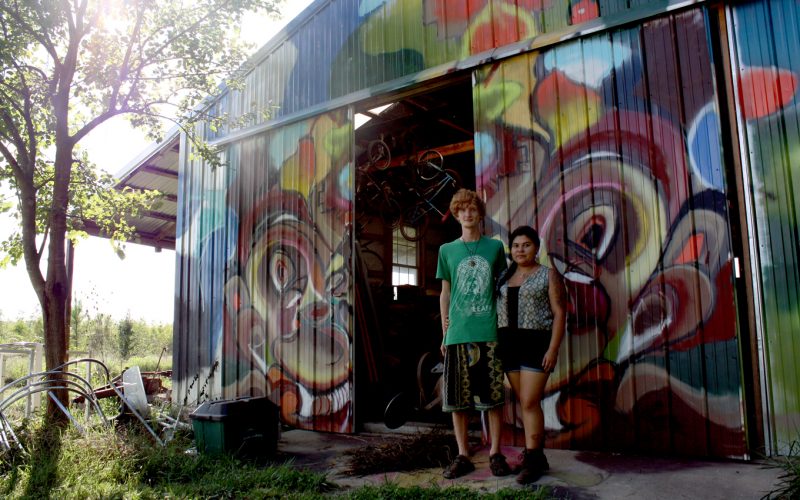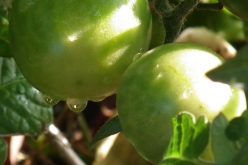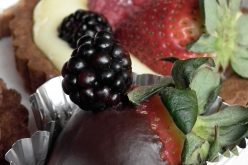
Staff Photos Nick Brothers
Tas Zinck (left) and Jeanie Hall (right), the founders of Living Earth Ark Food Forestries, stand in front of the mural supply shed on their farm, which is undergoing development to become an edible art park.
In the rolling hills of Northwest Arkansas, there’s more than 100 acres of farmland nestled near Dead Horse mountain in southeast Fayetteville. Upon entering the farm through a new suburban housing development off highway 16, in one area sits an old shed, painted in myriad vibrant colors constituting a mural-in-progress. Not far from it lies a slice of Americana with a Ford truck from the 80s seemingly being consumed by the tall grass. There’s a pond, as well as apple, peach and blueberry orchards. At the back end of the pasture, a forest path leads to a village of homes in the 30 acres of woods, all built with recycled materials.
In about a year, this land will be developed into an edible art park, where those interested can come to enjoy the environmental art and learn about sustainability and eco-agricultural practices for free.
This is all only about 5 miles away from the downtown Fayetteville square, and it’s soon to be connected to the bike trail system. That’s just the kind of connection the founders of Living Earth Ark Food Forestries (L.E.A.F.F.) want to have with the community of Fayetteville and Northwest Arkansas when they established the organization in the spring of 2014 with a group of students, artists, and activists in Fayetteville ranging in age from 20 to 55.
The group is foremost about spreading the knowledge and culture of sustainability through the developing art park, which they call an “ark” for preserving the Earth for the next generation. The plan is to establish this “ark” of sustainability as as an educational edible art park that would feature gardens, food forests, meditation art trails, green houses, a plant nursery, living sculptures, performance stages and eventually an eco village to house artists working at the park. The goal is set to open the park in 2015.
“We want to beautify sustainability, and show that it can be a luxurious thing,” said Jeanie Hall, art director for L.E.A.F.F., and co-founder. “You don’t have to sacrifice to do it. We plan on doing workshops and teaching classes here to show how accessible it really can be. We want people to be able to grow their own things. You can only do so much in a window garden. You can come out here and have a plot, and have people there who can teach you how to do it.”

Tas Zinck (left) and Jeanie Hall (right) walk along a bridge created using sheet metal and trash coated with cement. Eventually, the bridge will be decorated with mosaic. The area is just one of the first parts of the growing project of L.E.A.F.F.’s edible art park.
There are many plans to have artists come out to the farmland and create sculptures and other eco-art for the park. As of now, members are in the process of building a geodesic dome of bamboo, an integrated agricultural labyrinth, beehives, several gardens and eventually a performance stage, Hall said. Once things get growing, the founders want to incorporate the “edible” part of the park and make it possible for visitors to pick fresh fruit and vegetables from the trees, vines and plants to eat while walking around.
The land is owned by Hall’s father, who grew up in Fayetteville. The main cost of using the land only comes through a property tax. Most of the art will be made through natural resources and recycled materials.
“Some people save up their entire lives to get land like this,” said Tas Zinck, co-founder and director of permaculture for L.E.A.F.F. “Since we do have elders to pass this on to us, it’s incredible. We’re thankful to be ahead in the game now.”
Forming the Roots
When Zinck and Hall first met, Zinck had already completed four years of working with permaculture — which is the development of self-sustaining ecosystems — and he had plans to do a bigger project. Hall introduced him to her family’s farmland, and they decided it was perfect for the L.E.A.F.F. project.
The foundation of the art park will rely on two sustainable techniques — permaculture and hugelkultur. The latter is a German technique meaning “hill-culture” that utilizes dead trees as garden beds. As the wood decomposes into the soil, the wood brings plenty of moisture and nutrients for the plants to utilize, as well as aerate the soil.

After taking a bite of an apple right from the tree, Tas Zinck explains the benefits of permaculture, a type of agriculture that is made so it is self-sustainable.
On the farm, there is a blueberry orchard — which yielded more than 160 gallons of berries — an apple and peach tree orchard, as well as elderberries, grapes and several types of peppers, potatoes, turnips and other vegetables. Many areas of produce rely on polyculture, which is a method of combining several types of produce in a shared space to promote biodiversity, Zinck said.
“We’ve had people we met at the farmer’s market that came out and brought their kids and picked blueberries in the orchard, and just being able to pass that on to the next generation and show them you can grow your own food,” Zinck said. “So many people have become so disenfranchised to gardening and farming that they think it’s hard. It’s crazy, because it’s so easy to grow your own food. Anybody can do it on a very small amount of land.”
With permaculture, there is a lot of labor that needs to be done up front, but once it’s set up properly it builds on itself, and all one has to do is harvest the produce, Zinck said.
“So many people have this idea about sustainability that it’s something you have to focus on completely,” Zinck said. “If you set up the permaculture right, it enables you to do whatever you want.”
Spreading Sustainable Seeds
Many traditional agricultural practices of tilling soil for crops, fertilizing, irrigation and monoculture are less sustainable for the land, causing chemicals to be introduced to replace lost nutrients in the soil, Zinck said.
However, many farmers have been trained in traditional methods, and government subsidies for farmers can, in effect, encourage them to continue farming with the less sustainable methods. This is why farmers are reluctant to switch to more sustainable agriculture, such as permaculture and polyculture which promote biodiversity and can suppress diseases, Zinck said.

With the blueberry season finished, members of L.E.A.F.F. were able to harvest more than 160 gallons of berries from their orchard.
However, monoculture creates an efficiency for farmers who want to invest resources in the harvesting of one crop, such as corn or wheat. Tilling is also efficient in killing weeds. The downside is, monoculture is more susceptible to insect damage and disease that can spread quickly among the crops, said Luke Freeman, a research technician at the University of Arkansas horticulture department.
Beyond the planning for the workshops, Zinck and Hall want to eventually be able to incorporate a music festival centered around sustainability on the farmland to draw in more varieties of people. Until then, L.E.A.F.F. is working to establish connections with local restaurants and organizations.
“We want to be a hub for people and the community to plug into,” Zinck said.
Still being relatively new, L.E.A.F.F. members are in the process of applying to be a 501c non-profit organization. If they are approved, they hope to be able to incorporate more sustainability students from the University of Arkansas and provide them with volunteer hours. Potentially, with 501c status, L.E.A.F.F. could help students get course credit from helping on the farm.
Both Hall and Zinck are also working with Don Bennett of Tri Cycle Farms, located off of Garland Avenue, to be a sister project. L.E.A.F.F. hopes to model after Tri Cycle’s “thirds share initiative,” in which they share a third of their produce with volunteers and pantries and a third goes to the farm. Eventually, Zinck said they want to be able to share art with Tri Cycle, and have members of Tri Cycle contribute gardens in return as a partnership.
“We really want to model after the best parts of all of these different projects that people already have going on,” Hall said. “Tri Cycle has three acres, and we have more than 100.
“It’s about taking these things and branching them out and making them more accessible to people.”










